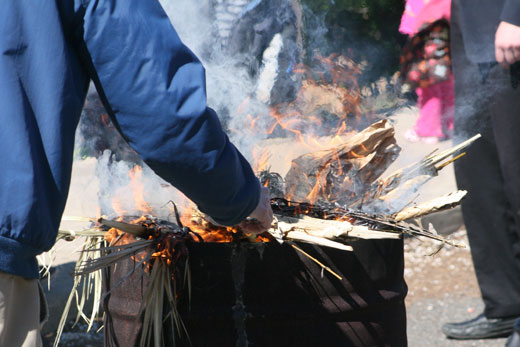
I call this photo “Azalea, meet Andromeda.”

My neighbor’s dogwood tree is once again flowering. My dogwood photos from 2008 are one of the most popular posts on this blog.

Dogwood blossoms are a pleasure, but one needs to be fast with the camera or the dogwood blossom season will be done.
One downside of the abundant blossoms in our area is my stuffed nose. Any of you allergy sufferers? A friend of my daughter’s hates spring because of allergies. Sigh.
For more Nature Notes:


Before Pesach we have a custom of burning chametz (bread, crackers, cereal, pasta, anything made of five grains: wheat, barley, rye, oats and spelt). When I was a kid, I remember burning chametz in our backyard. Now there are laws about creating fires, so observant Jews get special permission to burn chametz. This burning took place in Edison, New Jersey.

A tradition we have in our family (and others do as well) is to burn the lulav, the palm branch left over from Sukkot, the fall holiday in which we sit in a booth outside for a week.

In this photo you can see both lulavim (plural of lulav) and real bread. It got quite smokey – my husband doesn’t remember it being so smokey in the past. Maybe this is because the regular Edison staff were on vacation for Good Friday and a nice person was left in charge who didn’t quite manage the smoke? I don’t know, but I left there sniffing my clothes, wondering if I smelt like someone who had walked into a smokey bar.
I had enough time to attend biur chametz (burning of the chametz) this year because I managed to get all the cooking I had planned the day before and early in the morning. One of the most popular dishes among my sister-in-law’s family that I made was mushroom paté; personally, my favorite was the marinated beets with ginger and garlic. Planning to make both of those again tomorrow.

I photographed the cherry blossoms (pink flowers) in front of forsythia (yellow flowers).

The geese in Donaldson Park are enjoying the spring weather by the Raritan River.
We are getting ready for Passover (Pesach in Hebrew); one of the nicknames for Passover is Hag Ha’Aviv, the Holiday of Spring.
For more Nature Notes:


I placed and photographed natural and man made objects for the theme of green. How many green objects can you spot?
Thursday Challenge is “GREEN” (Fruit, Vegetables, Animals, Clothing, Vehicles,…)
Next Week: THREE (Triplets, Trio, Triptych, Triangle,…)

I decided to go for minimalist and photographed garlic cloves.
Thursday Challenge is “FOOD” (Food Markets, Ingredients, Cooking, Baking, Pots, Pans,…).
Next week is GREEN (Fruit, Vegetables, Animals, Clothing, Vehicles,…).










